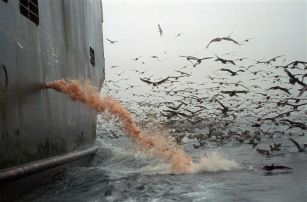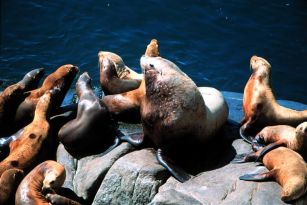This is a guest post by John Hocevar and Jeremy Jackson. Jeremy Jackson is the William E. and Mary B. Ritter Professor of Oceanography at the Scripps Institution. John Hocevar is a marine biologist and the director of Greenpeace’s oceans campaign.
 If you like seafood, you’ve probably eaten Alaska pollock, the tender white fish used in most frozen fish sticks, McDonald’s Filet-O-Fish sandwiches, and the imitation crab meat found in California rolls. But the pollock – the world’s largest food fishery – is on the verge of collapse.
If you like seafood, you’ve probably eaten Alaska pollock, the tender white fish used in most frozen fish sticks, McDonald’s Filet-O-Fish sandwiches, and the imitation crab meat found in California rolls. But the pollock – the world’s largest food fishery – is on the verge of collapse.
The most recent data from the National Marine Fisheries Service show the pollock population approaching the lowest level ever recorded; since 2003, the population has declined from 8.5 million tons to 3 million tons. That’s bad news for fish eaters and fishermen alike, and really bad news for Alaska’s extraordinary ocean ecosystem.
Even as the pollock – and the wildlife that rely on them – have declined, the government has allowed overfishing to continue. Incredibly, these steep declines do not even meet the government’s definition of overfished.
As a result, two of Alaska’s four pollock fisheries have been closed and a third is just a fraction of its former size. Until recently, though, the strength of the Bering Sea pollock stock was sufficient to support a billion dollar industry and earn a “sustainable” rating from the Marine Stewardship Council.
But like economics, fisheries management involves too many variables and too much uncertainty for anyone to make precise predictions. And, as with the economy, when large amounts of money are at stake, managers tend to downplay that uncertainty and hope for the best.
That’s exactly what happened to the Atlantic cod, the pollock’s close relative, and the previous holder of the title “world’s biggest food fishery.” For years, the Atlantic fish industry refused to heed the warning signs that cod was in serious trouble, and tighter regulation was needed.
 When policy makers did finally act, in 1992, it was too late – and the fishery crashed to less than one percent of its former level. By 1994, the fishery, which had been active since at least the beginning of the 16th century, had to be closed. Suddenly, more than 40,000 people were out of work and the industry went begging to the government for a multi-billion dollar bailout.
When policy makers did finally act, in 1992, it was too late – and the fishery crashed to less than one percent of its former level. By 1994, the fishery, which had been active since at least the beginning of the 16th century, had to be closed. Suddenly, more than 40,000 people were out of work and the industry went begging to the government for a multi-billion dollar bailout.
Today, the North Pacific Fisheries Council seems to be repeating the cod tragedy.
Despite the warning signs, including several years of low juvenile survivorship, the Council continues to allow trawlers to kill the fish that lay the golden eggs. Each winter, factory trawlers brave the stormy Bering Sea to target spawning pollock, killing huge numbers of pregnant females before they release their eggs, or roe. The roe fishery is lucrative but ecologically dangerous even in the best of times. At a time when the pollock population needs all the offspring it can produce – and global warming seems to be putting additional stress on the fishery – it’s just reckless. The Council members (mostly representatives of the fishing industry) persist in saying that we can trust the industry to police itself – and are increasingly sounding like the Alan Greenspans of the sea.
 It’s still theoretically possible that environmental conditions will allow for a season of epic pollock reproduction that will begin to re-build the stock. If we continue with business as usual,though, it’s more likely that the fishery will collapse, with devastating consequences for the wildlife and people of Alaska.
It’s still theoretically possible that environmental conditions will allow for a season of epic pollock reproduction that will begin to re-build the stock. If we continue with business as usual,though, it’s more likely that the fishery will collapse, with devastating consequences for the wildlife and people of Alaska.
The next year or two may be our last chance to save the fishing industry from itself. The key will be in taking action before things reach the point of no return, as appears to have happened with cod. Most immediately, the pollock catch needs to be cut significantly, and the roe fishery should be suspended.
Many of the measures necessary to save the pollock fishery are just as needed in other fisheries around the country that are also reeling from overfishing. Across our oceans, fish have nowhere to find refuge and replenish their population – which is why we need to move quickly to establish a network of no-take marine reserves.
Until we move from simply managing fisheries in a vacuum to protecting the ecosystems that sustain them, fisheries managers will continue to be surprised by one economic and ecological disaster after another – and taxpayers could find themselves on the hook for yet another multi-billion dollar bailout.

